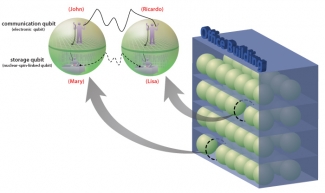Fellows Ana Maria Rey and Jun Ye have come up with a clever idea that should make it much easier to design a quantum computer based on alkaline-earth atoms such as strontium (Sr). In this work, they collaborated with former research associate Marty Boyd, former JILA Fellow Peter Zoller (University of Innsbruck), and colleagues from Harvard University and the University of Innsbruck.
To understand the new quantum computing idea, it’s helpful to imagine a high-tech company as a quantum computer and pairs of employees as the atoms at the heart of the system. In older formulations of quantum information processing, everyone in the company would be working in unison toward the same goal: to stay coherent. That’s actually very challenging, even for atoms. Consequently, no one has yet come up with a scheme to make this happen.
Rey and her collaborators' insight was that it would be a lot easier for a company to keep each work unit, or office, coherent, but linked to the rest of the firm via a communication system. Each office, or local processor, would be a quantum register. Each register would contain one pair of employees, a configuration analogous to a single Sr atom. Each office (register) would not only work in perfect harmony, but also create less resonance demand on the company (computer) than if every office had to always be in sync.
Imagine that John and Mary run the company’s communications office; they are also a single Sr atom. John’s communication function is analogous to a specific electronic transition, or qubit, in a Sr atom. Mary is responsible for information storage, which is mapped on the nuclear spin states of the same Sr atom. John and Mary are in a mind meld (superposition). They’re working on a company newsletter article about the theory behind the new light saber under development at the company. Ricardo and Lisa are the lead engineers on the project and just happen to be discussing it in Ricardo’s office. The two engineers are also a single Sr atom in a mind meld (superposition). Lisa contains the information-storage qubits, and Ricardo is the communication qubit.
When the communications office has a draft of the article and a great picture to show to Lisa and Ricardo, it activates a communication link to Ricardo’s office. First, a precision laser moves the communications office a short distance and sets it down next to Ricardo’s office. Second, a magic room partition, i.e., a quantum gate, opens up between the two offices. Now John, Mary, Ricardo and Lisa enter a gigantic mind meld (4-party entanglement) to swap information about the newsletter and recommend changes. What’s really neat is that if the company had a really big project — like building a commercial quantum computer, then everybody’s qubits could get entangled so all the company offices could work together at the same time!
The best part about our local processing example is that only the communication qubits (John and Ricardo) actually probe each other’s minds. However, they can exchange all the information stored in Mary’s and Lisa’s minds, but the process doesn’t disturb these nuclear-spin-linked qubits. Because they aren’t perturbed, Mary keeps the coherence going in the communications office and Lisa keeps the coherence intact in Ricardo’s office. That’s important because the communications office and Ricardo’s office will surely need to be involved in other company projects.
All the company’s projects depend on having quantum gates. According to Rey’s formulation, these phase gates would consist of double quantum wells, with Sr atoms on either side. Atoms in the ground state with opposite spins could tunnel to the other side of the well (raise the room partition) and get entangled and communicate with the atom on the other side. Other atoms couldn’t get through the gate.
Luckily, precision lasers can detect and change the phase of any ground-state Sr atom. This means communication could be controlled by rotating ground-state qubits into states in which they can tunnel. The ability to control communication, together with the ability to measure (and control) the states of individual Sr atoms, are the essential ingredients of Rey’s new quantum computer theory. The only hitch so far is that a Sr quantum computer would have to be cooled to nK temperatures to work. A high-tech company might not like that aspect of being a quantum computer so much. - Julie Phillips



 The Physics Frontiers Centers (PFC) program supports university-based centers and institutes where the collective efforts of a larger group of individuals can enable transformational advances in the most promising research areas. The program is designed to foster major breakthroughs at the intellectual frontiers of physics by providing needed resources such as combinations of talents, skills, disciplines, and/or specialized infrastructure, not usually available to individual investigators or small groups, in an environment in which the collective efforts of the larger group can be shown to be seminal to promoting significant progress in the science and the education of students. PFCs also include creative, substantive activities aimed at enhancing education, broadening participation of traditionally underrepresented groups, and outreach to the scientific community and general public.
The Physics Frontiers Centers (PFC) program supports university-based centers and institutes where the collective efforts of a larger group of individuals can enable transformational advances in the most promising research areas. The program is designed to foster major breakthroughs at the intellectual frontiers of physics by providing needed resources such as combinations of talents, skills, disciplines, and/or specialized infrastructure, not usually available to individual investigators or small groups, in an environment in which the collective efforts of the larger group can be shown to be seminal to promoting significant progress in the science and the education of students. PFCs also include creative, substantive activities aimed at enhancing education, broadening participation of traditionally underrepresented groups, and outreach to the scientific community and general public.